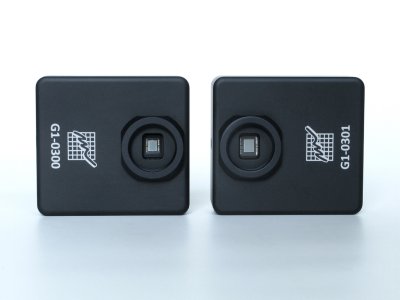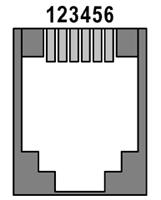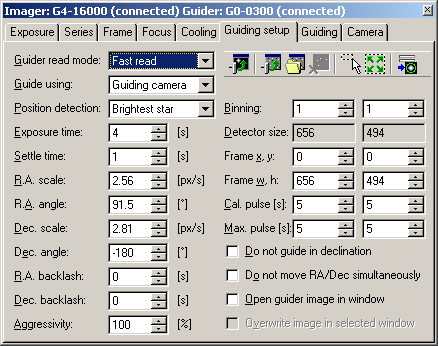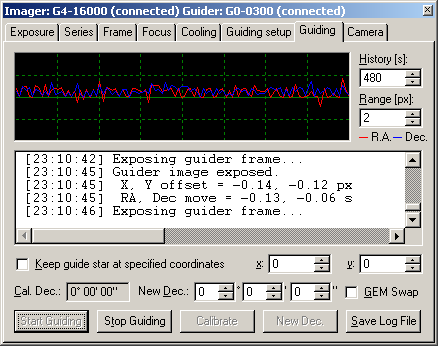|
Amount of light, gathered by each pixel, is proportional to its
area. G1-0301 camera pixels with 9.9 × 9.9 μm
dimensions offer 1.8 times the area of 7.4 × 7.4 μm
pixels of the G1-0300 model (and almost 7 times greater area than the G1-1200 pixels).
G1-0301 was designed for long focal length guiding telescopes and also
for usage with Off-Axis Guider (OAG) adapters. The guiding camera uses
the same optics like the main imaging camera when attached to OAG.

Comparison of G1-0300 (left) and G1-0301 (right) shows
greater detector area Relatively large package of the ICX414 CCD does not allow its
placing inside the small head of G0 cameras. The 0301 model is
available in the larger G1 camera head only.
The G1-0301 camera head is identical to all G1
cameras... ...including the “tripod” thread (left), USB and
standard “autoguider” port (right). The G1-0301 cameras are available in both color and monochrome
variants:
| Model |
CCD detector |
Chip architecture |
Color filters |
Resolution |
Pixel size |
Image area |
Download time |
| G1-0301 |
ICX414AL |
progressive |
none |
656 × 494 |
9.9 × 9.9 μm |
6.5 × 4.9 mm |
~ 0.05 s |
| G1-0301C |
ICX414AQ |
progressive |
RGBG (Bayer) |
656 × 494 |
9.9 × 9.9 μm |
6.5 × 4.9 mm |
~ 0.05 s |
Image digitization speed can be chosen between
2.5 MPx/s and
8 MPx/s. The whole image can be
downloaded in a fraction of second, which is particularly important
for automatic guider. Analog/Digital converter resolution is
16 bits (65,536 levels), which is even more than
the dynamic range of the used CCD detector.
The CCD detector is equipped with electronic shutter, which allows
capturing of very short exposures (shortest exposure is 125 μs). Longest exposure is on
the other side limited only by the detector saturation, which allows
automatic guiding using much dimmer stars compared to the best web or
TV cameras. When coupled with a guiding telescope with focal length
around 30 cm and diameter around
8 cm, G1-0301 can detect guiding star
after several seconds of exposure time almost anywhere on the night
sky.
As well as other G0/G1 cameras also the G1-0301 is equipped with
standard “autoguider” port. This port allows direct connection
of camera and telescope mount compatible with this standard,
introduced by SBIG. The G1-0301 camera has mount switching circuits
isolated from the rest of the system (camera itself, USB and host
computer), which enhances reliability and noise resistance. Maximum
switching current is 150 mA and on state
resistance around 10 Ω.
 |
| 1 |
R.A. + (Right) |
| 2 |
Dec + (Up) |
| 3 |
Dec – (Down) |
| 4 |
R.A. – (Left) |
| 5 |
Common (Ground) |
| 6 |
Not connected |
|
G0/G1 camera autoguider port pins The guiding itself is performed by the SIPS (Scientific Image
Processing System) software or by other camera control software, for
which G0/G1 camera driver exists (e.g. The Sky or MaxIm DL)
or which is capable to use general ASCOM camera drivers. Automatic
guiding running in SIPS utilizes the computational power of modern PCs
to achieve sub-pixel precision of star position, so it can guide very
precisely even if a guiding telescope with short focal length is
used.

Guiding setup tab in the CCD Camera tool of SIPS
software SIPS software performs not only guiding, but also allows automatic
calibration independently on camera orientation, recalculates
calibration parameters when the telescope is moved to different
declination so no calibration is needed. The guide star can be kept on
defined pixel coordinates, which allows placing of the guide star on
the same position during subsequent observations etc. Differences from
reference positions are displayed graphically and all guiding actions
including measured differences and performed corrections are logged
into text window and can be saved into text file.

Guiding tab in the CCD Camera tool of SIPS
software | 